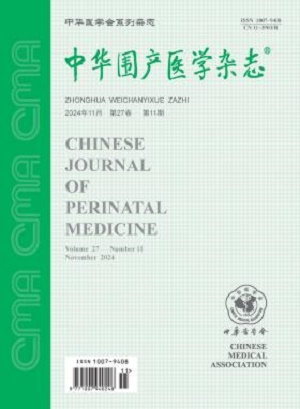Long-term effects of regular exercise during pregnancy on overweight and obese gravidas: one-year follow-up of a previous randomized controlled trial
Q4 Medicine
引用次数: 0
Abstract
Objective To investigate the long-term effects of regular exercise during pregnancy on overweight and obese gravidas. Methods This study was based on a previous randomized controlled trial (RCT) regarding Effect of Regular Exercise Commenced in Early Pregnancy on the Incidence of Gestational Diabetes Mellitus in Overweight and Obese Pregnant Women conducted at Peking University First Hospital from December 2014 to July 2016. Totally 265 women whose prepregnant body mass index (BMI) ≥24.0 kg/m2 were enrolled in the RCT and were randomly assigned to exercise group (n=132) and control group (n=133). This study was a follow-up of all the participants at one year after delivery from March 2016 to August 2017. Body weight, body fat, fasting and 2 h glucose level in 75 g oral glucose tolerance test (OGTT), insulin resistance index and lipid profiles were compared. We also evaluated their physical activities with International Physical Activity Questionnaire (IPAQ), their dietary habits with modified Adult Dietary Behavior Assessment Scale and depression condition with Postpartum Depression Screen Scale (PDSS). Two independent samples t-test, Mann-Whitney U test and Chi-square test were used for statistical analysis. Results The overall follow-up rate was 51.7% (137/265), while 64.4% (85/132) in the exercise group and 39.1% (52/133) in the control group. No significant difference in body weight loss [2.3 (-6.0 to 5.0) vs 1.0 (-1.3 to 4.7) kg], body fat percentage [(38.04±4.54)% vs (37.51±4.90) %], 2 h glucose level in 75 g OGTT [(7.30±2.80) vs (7.32±1.61) mmol/L], abnormal glucose tolerance ratio [30.0% (9/30) vs 28.8% (17/59)] or insulin resistance index (2.92±1.77 vs 2.86±1.92) was found between the control and exercise group (t or Z=-0.940, 0.312, 3.415, 0.005, 1.743, all P>0.05). However, the fasting blood glucose in 75 g OGTT was higher in the control group [(5.53±0.92) vs (5.28±0.43) mmol/L, t=9.268, P=0.003]. The two groups showed no significant difference (exercise group vs control group) in physical activity level [219 (99-504) vs 195 (99-351)], total score of dietary habits [79.00 (72.50-87.50) vs 76.00 (70.00-82.00)] or PDSS score of depression [55.00 (41.00-77.00) vs 70.00 (46.25-84.75)] at follow-up (Z=-0.808, -1.822, -1.620, all P>0.05). Moreover, there was no significant difference in the level of serum triglyceride [(1.25±1.04) vs (1.42±0.85) mmol/L], total cholesterol [(4.56±0.71) vs (4.40±0.67) mmol/L], high density lipoprotein-cholesterol [(1.32±0.29) vs (1.22±0.21) mmol/L] or low density lipoprotein-cholesterol [(2.67±0.56) vs (2.55±0.52) mmol/L] between the exercise and control group (t=0.001, 0.020, 3.255, 0.303, all P>0.05). Conclusions Regular exercise during pregnancy has no long-term effect on maternal health in the absence of continuing lifestyle intervention after delivery. Therefore, postpartum follow-up and continued education on healthy lifestyle should be emphasized. Key words: High body mass index; Exercise intervention; Postpartum; Long-term outcomes of mothers and offspring怀孕期间定期运动对超重和肥胖孕妇的长期影响:先前随机对照试验的一年随访
目的探讨孕期规律运动对超重和肥胖孕妇的长期影响。方法本研究基于2014年12月至2016年7月在北京大学第一医院进行的关于妊娠早期定期运动对超重和肥胖孕妇妊娠糖尿病发病率影响的随机对照试验(RCT)。共有265名孕妇的孕前体重指数(BMI)≥24.0 kg/m2参加随机对照试验,并被随机分为运动组(n=132)和对照组(n=133)。本研究是对所有参与者在2016年3月至2017年8月分娩后一年的随访。比较75g口服葡萄糖耐量试验(OGTT)中的体重、体脂、禁食和2小时葡萄糖水平、胰岛素抵抗指数和脂质状况。我们还用国际体力活动问卷(IPAQ)评估他们的体力活动,用改良的成人饮食行为评估量表评估他们的饮食习惯,用产后抑郁筛查量表评估抑郁状况。采用两个独立样本t检验、Mann-Whitney U检验和卡方检验进行统计分析。结果总随访率为51.7%(137/265),运动组为64.4%(85/132),对照组为39.1%(52/133)。体重减轻[2.3(-6.0至5.0)vs 1.0(-1.3至4.7)kg]、体脂百分比[(38.04±4.54)%vs(37.51±4.90)%]、75 g OGTT 2 h葡萄糖水平[(7.30±2.80)vs(7.32±1.61)mmol/L]无显著差异,对照组与运动组糖耐量比值为30.0%(9/30)vs 28.8%(17/59),胰岛素抵抗指数为2.92±1.77 vs 2.86±1.92(t或Z=-0.940,0.312,3.415,0.005,1.743,均P>0.05),对照组75g OGTT空腹血糖升高[(5.53±0.92)vs(5.28±0.43)mmol/L,t=9.268,P=0.003]。两组(运动组与对照组)体力活动水平无显著差异[219(99-504)vs 195(99-351)],随访时饮食习惯总分[79.00(72.50-87.50)vs 76.00(70.00-82.00)]或抑郁症PDSS评分[55.00(41.00-77.00)vs 70.00(46.25-84.75)](Z=-0.808,-1.822,-1.620,均P>0.05)。此外,血清甘油三酯水平[(1.25±1.04)vs(1.42±0.85)mmol/L]、总胆固醇水平[(4.56±0.71)vs(4.40±0.67)mmol/L],运动组与对照组的高密度脂蛋白胆固醇[(1.32±0.29)vs(1.22±0.21)mmol/L]或低密度脂蛋白脂蛋白胆固醇][(2.67±0.56)vs(2.55±0.52)mmol/L](t=0.001、0.020、3.255、0.303,均P>0.05)。因此,应重视产后随访和健康生活方式的继续教育。关键词:高体重指数;运动干预;产后;母亲和后代的长期结果
本文章由计算机程序翻译,如有差异,请以英文原文为准。
求助全文
约1分钟内获得全文
求助全文
来源期刊

中华围产医学杂志
Medicine-Obstetrics and Gynecology
CiteScore
0.70
自引率
0.00%
发文量
4446
期刊介绍:
Chinese Journal of Perinatal Medicine was founded in May 1998. It is one of the journals of the Chinese Medical Association, which is supervised by the China Association for Science and Technology, sponsored by the Chinese Medical Association, and hosted by Peking University First Hospital. Perinatal medicine is a new discipline jointly studied by obstetrics and neonatology. The purpose of this journal is to "prenatal and postnatal care, improve the quality of the newborn population, and ensure the safety and health of mothers and infants". It reflects the new theories, new technologies, and new progress in perinatal medicine in related disciplines such as basic, clinical and preventive medicine, genetics, and sociology. It aims to provide a window and platform for academic exchanges, information transmission, and understanding of the development trends of domestic and foreign perinatal medicine for the majority of perinatal medicine workers in my country.
 求助内容:
求助内容: 应助结果提醒方式:
应助结果提醒方式:


